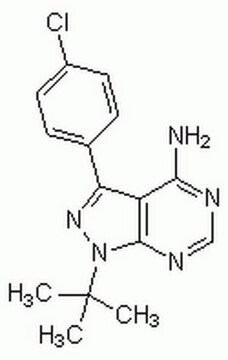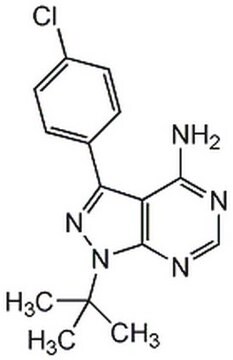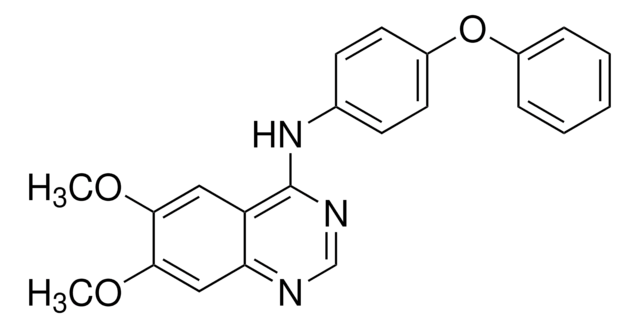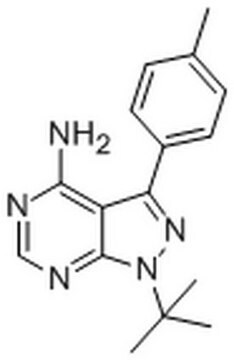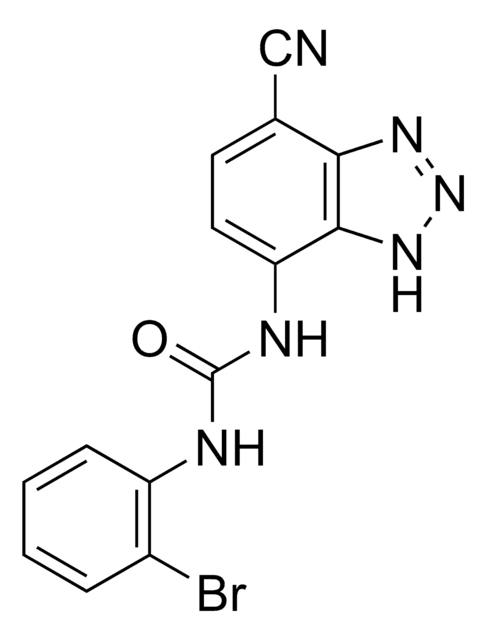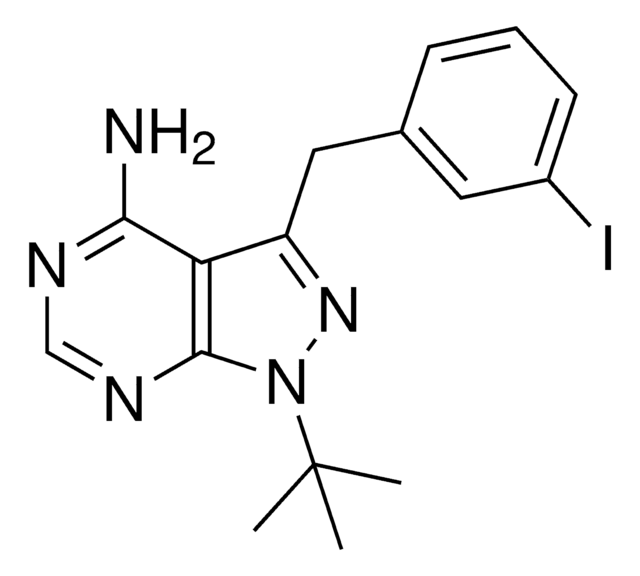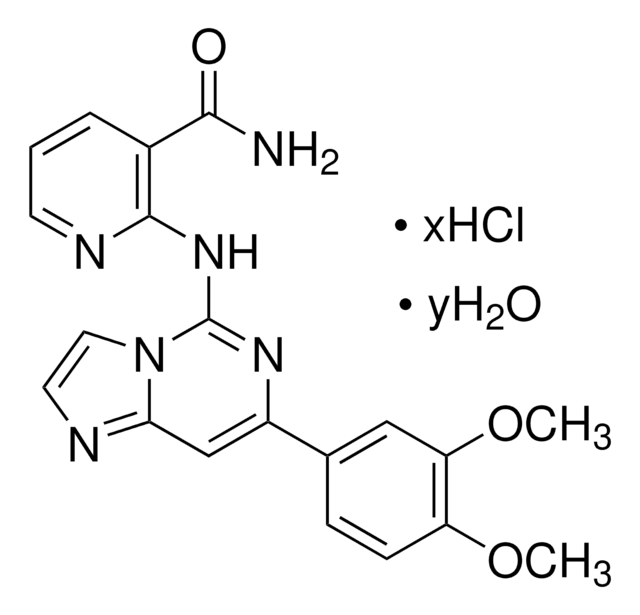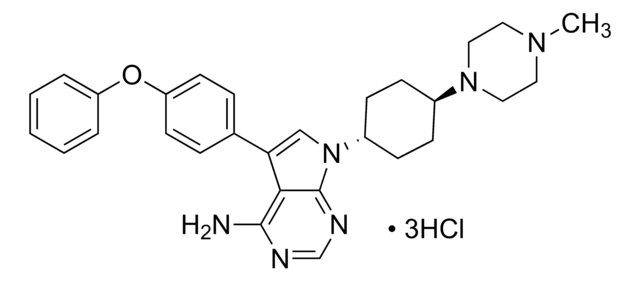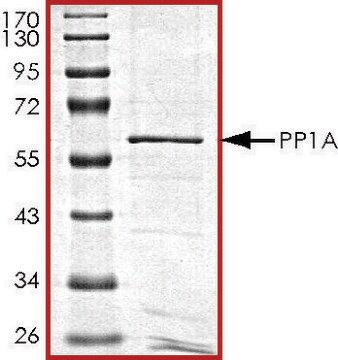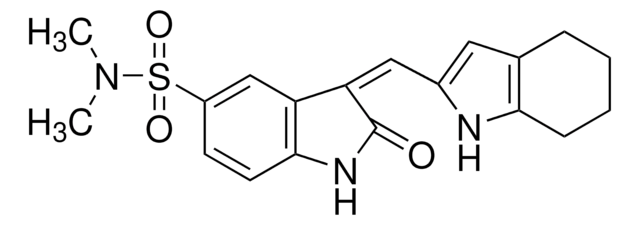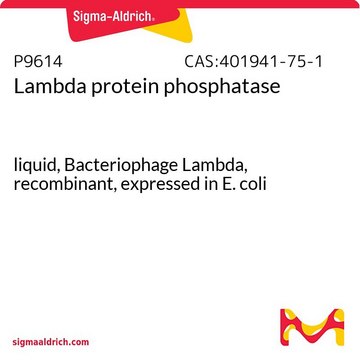Wszystkie zdjęcia(1)
Kluczowe dokumenty
P0040
PP1
≥98% (HPLC)
Synonim(y):
4-Amino-5-(methylphenyl)-7-(t-butyl)pyrazolo-(3,4-d)pyrimidine
Zaloguj sięWyświetlanie cen organizacyjnych i kontraktowych
About This Item
Wzór empiryczny (zapis Hilla):
C16H19N5
Numer CAS:
Masa cząsteczkowa:
281.36
Numer MDL:
Kod UNSPSC:
12352200
Identyfikator substancji w PubChem:
NACRES:
NA.77
Polecane produkty
Próba
≥98% (HPLC)
Formularz
powder
kolor
white to off-white
rozpuszczalność
DMSO: >20 mg/mL
temp. przechowywania
room temp
ciąg SMILES
Cc1ccc(cc1)-c2nn(c3ncnc(N)c23)C(C)(C)C
InChI
1S/C16H19N5/c1-10-5-7-11(8-6-10)13-12-14(17)18-9-19-15(12)21(20-13)16(2,3)4/h5-9H,1-4H3,(H2,17,18,19)
Klucz InChI
ZVPDNRVYHLRXLX-UHFFFAOYSA-N
Zastosowanie
PP1 has been used as:
- an inhibitor of sarcoma (Src) family kinases (SFK) like hematopoietic cell kinase (hck) and fyn
- a selective Src tyrosine kinase inhibitor in hippocampal neuronal cultures to test its effect on neurite growth
- a Src-kinase blocker to test its effect on brimonidine (BMD)-induced phosphorylation in extracellular signal-activated kinases(ERK1/2)
Działania biochem./fizjol.
PP1 is a potent and selective Src family protein tyrosine kinase inhibitor.
PP1 is a pyrazolopyrimidine compound that acts as a competitive inhibitor of adenosine triphosphate (ATP) binding. It also inhibits protein tyrosine kinase (PTK6) and may be useful in the therapeutic management of PTK6 positive based breast cancer malignancy.
Cechy i korzyści
This compound is a featured product for Kinase Phosphatase Biology research. Click here to discover more featured Kinase Phosphatase Biology products. Learn more about bioactive small molecules for other areas of research at sigma.com/discover-bsm.
Ta strona może zawierać tekst przetłumaczony maszynowo.
Kod klasy składowania
11 - Combustible Solids
Klasa zagrożenia wodnego (WGK)
WGK 3
Temperatura zapłonu (°F)
Not applicable
Temperatura zapłonu (°C)
Not applicable
Wybierz jedną z najnowszych wersji:
Masz już ten produkt?
Dokumenty związane z niedawno zakupionymi produktami zostały zamieszczone w Bibliotece dokumentów.
Klienci oglądali również te produkty
Qian Wang et al.
Environmental science and pollution research international, 26(21), 21774-21783 (2019-05-28)
Due to variable amino acid residues at positions 2 and 4, microcystins (MCs) had diversified variants with different toxicities. To evaluate the discrepant toxicity, the inhibition effects of five typical MC variants (with the changed amino acid residues at position
Katyayni Vinnakota et al.
Journal of cellular physiology, 232(12), 3468-3480 (2017-01-18)
The inflammatory milieu plays an important role in colon cancer development and progression. Previously, we have shown that tumor-associated macrophages (TAMs), an important component of the tumor microenvironment, are enriched in tumors compared with normal tissue and confer a poorer
Shunyu Gao et al.
General and comparative endocrinology, 240, 46-60 (2016-10-23)
Neuropeptide Y (NPY) receptors and its ligands, NPY, peptide YY (PYY) and pancreatic polypeptide (PP), are suggested to regulate many physiological processes including food intake in birds. However, our knowledge regarding this avian NPY system remains rather limited. Here, we
Xiaotong Zhu et al.
International journal for parasitology, 49(9), 685-695 (2019-06-17)
Sexual development in malaria parasites involves multiple signal transduction pathways mediated by reversible protein phosphorylation. Here, we functionally characterised a protein phosphatase, Ser/Thr protein phosphatase 5 (PbPP5), during sexual development of the rodent malaria parasite Plasmodium berghei. The recombinant protein
Jun Mori et al.
Blood, 131(10), 1122-1144 (2018-01-06)
Src family kinases (SFKs) coordinate the initiating and propagating activation signals in platelets, but it remains unclear how they are regulated. Here, we show that ablation of C-terminal Src kinase (Csk) and receptor-like protein tyrosine-phosphatase CD148 in mice results in
Nasz zespół naukowców ma doświadczenie we wszystkich obszarach badań, w tym w naukach przyrodniczych, materiałoznawstwie, syntezie chemicznej, chromatografii, analityce i wielu innych dziedzinach.
Skontaktuj się z zespołem ds. pomocy technicznej

